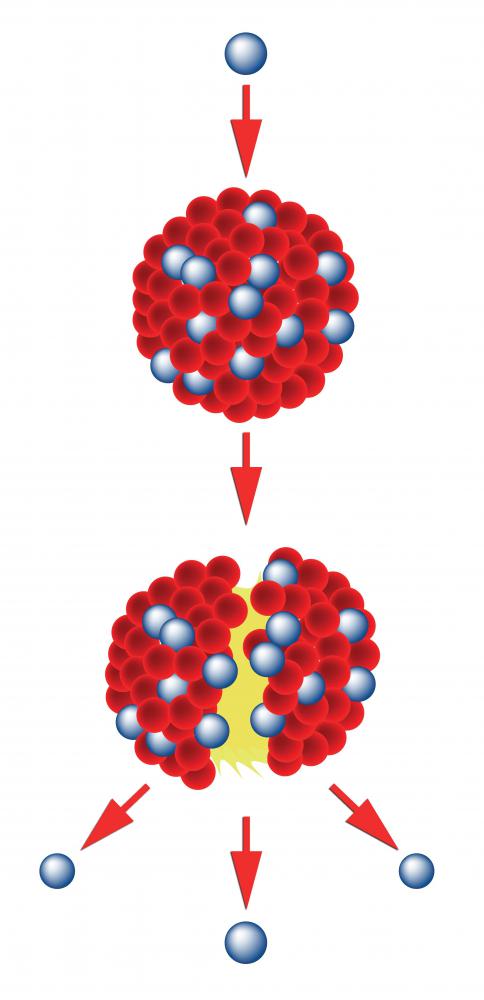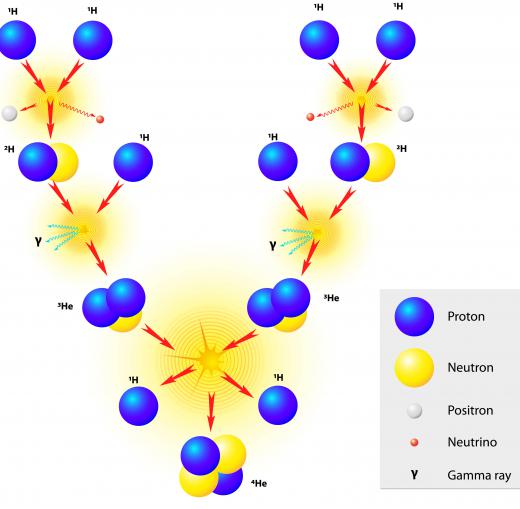What is the Difference Between Fission and Fusion?
 Michael Anissimov
Michael Anissimov
Fission and fusion are different types of nuclear reactions in which energy is released from the high-powered bonds between particles in the atomic nucleus. The atomic nucleus is most stable when binding energies between particles are strongest. This occurs with iron and nickel. For lighter atomic nuclei, energy can be extracted by combining these nuclei together, a process known as nuclear fusion. For nuclei heavier than those of iron or nickel, energy can be extracted by splitting them apart in a process called nuclear fission.
Because the binding force in the atomic nucleus contains enormous energy, nuclear reactions can provide tons of power, in principle. Practical considerations make the exploitation of nuclear power more difficult than something as simple as starting a fire, however. For fission, highly purified feedstock, usually uranium or plutonium isotopes, must be used. Isotopes are favored because their instability makes them easier to break apart. The purification of these isotopes is extremely expensive and requires multimillion-dollar centrifuges.

In fusion, an extremely high threshold energy must be reached to combine atomic nuclei, and the temperature required is in the millions of degrees. In nature, the only place where this occurs is in the core of a star. Superheated plasma and the focusing of laser power are two methods to achieve this threshold energy. Because the matter that serves as the medium of fusion must be so hot, it must be isolated from surrounding matter using powerful magnetic fields or inertial containment, which is the principle behind the Tokamak reactor. Still, fusion requires so much energy that no one has yet built a reactor that produces more than it consumes.

The downsides to fission power include both radioactive byproducts and its association with nuclear weapons and meltdowns. In the last decade or so, nuclear physicists have developed safer ways of building reactors, including methods for recycling the radioactive byproducts. These advances have caused the US government to begin advocating the construction of nuclear reactors again.
AS FEATURED ON:
AS FEATURED ON:













Discussion Comments
@anon3252: I think dominoes represent nuclear power. I might be wrong, but that's what I was told.
So fusion is combining atoms and fission is splitting them.
Thank you anon64885. Your post really helped clarify some questions I had.
thanks a lot but how was it discovered?
This was perfect!
Fusion is more difficult than fission because reactors required to produce huge amount of heat for the fusion reaction to takes place is very, very expensive to produce.
That was helpful.
Fusion is the process of bringing light nuclei together; fission is the process of splitting larger unstable nuclei.
In fusion the positive nuclei of two atoms must be brought together close enough for the nuclear force to be stronger than the repulsive electromagnetic force; to achieve that massive amounts of energy go into heating the nuclei until they have enough energy to fuse.
In the simplest case fusion involves isotopes of hydrogen (the smallest element) to combine thus forming helium (the second smallest element) and producing energy.
The issue is heating the hydrogen atoms enough so that they have enough energy to get close enough to fuse; the heat easily leaks out and lowers the temperature too much for the reaction to continue in a typical magnetically confined tokamak reactor (the reactor is magnetically confined because when a gas, like hydrogen, is heated up enough it becomes a plasma which is a state of matter that is easily manipulated by magnetic fields. One would definitely want to have some control over the reaction especially one this hot).
In an inertial confinement fusion reactor a giant laser shoots a hydrogen pellet in the hopes of creating fusion but in this case sustainability becomes an issue because essentially explosion after explosion must be maintained. With nuclear fission, already unstable isotopes of both uranium and plutonium are split by a neutron with sufficient kinetic energy. The nuclei of these heavy elements split releasing energy and more neutrons to continue the process of splitting other nuclei.
From an engineering and science standpoint, this is significantly easier than fusion because the only requirements for fission to occur is a steady supply of neutrons with enough energy to split heavy nuclei, which themselves produce neutrons with enough energy to successfully cause other fissions and so the reaction is readily sustainable.
Hope that answers any questions.
Well for fission to occur extremely high temps are needed cause a change of state change to plasma, which has a high potential energy in its atoms making it hard to confine. Confinement is the problem.
Great! That helped.
thanks. That really helps a lot!
Why is fusion more difficult than fission?
What is something that illustrates the difference between fusion and fission? Like what kind of object?
Post your comments